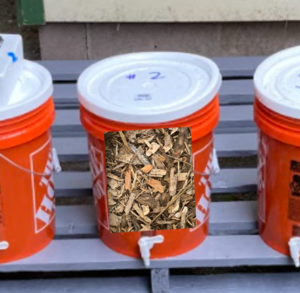
College of Engineering Unit:
Nitrate is the most widespread pollutant in ground and surface water across the globe. Nitrate pollution is common in agricultural areas due to animal waste and the use of nitrogen fertilizers. Nitrate pollution originates in the form of ammonium which is oxidized through nitrification to nitrate. Nitrate is easily soluble and can contaminate soil, groundwater, and surface water. Nitrate-rich runoff can then flow into local waterways. High concentrations of nitrate in drinking water can be lethal to humans and animals. Nitrate also disrupts the balance of aquatic ecosystems by toxifying water, resulting in eutrophication. It is therefore important to monitor and treat effluent water leaving an area with high nitrate concentrations. The main process for remediating nitrate is denitrification, the process by which nitrate is converted to nitrogen gas through anaerobic microbial respiration. An anaerobic environment forces denitrifying organisms to use nitrate as an electron acceptor and available organic carbon as an electron donor, reducing nitrate to nitrogen gas and nitrous oxide. The carbon is also a substrate where the biofilm of denitrifying bacteria can establish. These bacteria have an optimal temperature range for growth of 82℉ to 97°F, with decreasing growth at lower temperature. Temperatures below 41℉ can kill denitrifying bacteria, so maintaining suitable temperatures in a denitrification system is important. Our site of interest is the OSU dairy barn fields located on Campus Way, Corvallis OR. The manure produced by the cows on the farm is collected and used to fertilize the fields, proposing the potential for runoff with high nitrate concentration. The Biofiltro team is tasked with designing a system that will reduce the effluent nitrate concentration to less than 10 mg/L in the surface runoff from the 11.7 acre field west of the dairy. The system will be designed to treat a maximum flow rate of a 2 year storm event under winter conditions. Four potential designs were investigated including a tile drainage woodchip bioreactor, a constructed wetland, a vegetative ditch, and a surface runoff woodchip bioreactor. A comparison of designs determined that pairing the vegetative ditch and surface runoff woodchip bioreactor was the optimal design. We used relevant scoping calculations to calculate the runoff flow and needed bioreactor dimensions for our target nitrate concentration. We created a prototype woodchip bioreactor consisting of 5 gallon buckets filled with wood chips and soil taken from the site, which was used to establish a biofilm of denitrifying bacteria through inoculation. We used our prototype to experimentally determine the effective hydraulic retention time for reducing nitrate concentrations. Our findings were used to help parameterize the dimensions of our wood chip bioreactor and incorporate this to the overall design for the site.